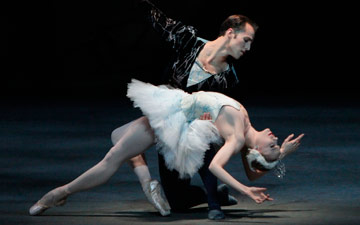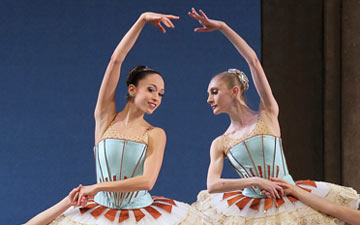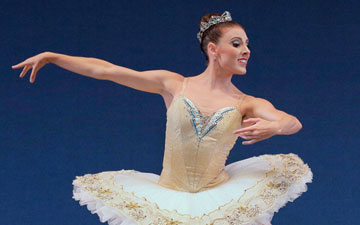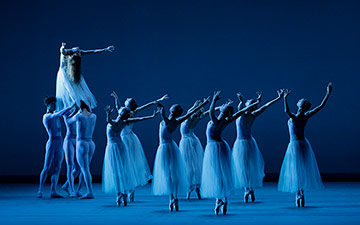
© Paul Kolnik. (Click image for larger version)
New York City Ballet
All Balanchine: Allegro Brillante, La Source, Firebird
★★★★✰
New York, David H. Koch Theater
30 January 2020
www.nycballet.com
davidhkochtheater.com
Dance to the Music
Every season at New York City Ballet since the replacement of Peter Martins by a team of two – Wendy Whelan and Jonathan Stafford – has begun with the question: how is the company looking? How has it changed under new management? How is the core repertory faring? The first week, which usually features all-Balanchine programs, is like a barometric test. This season began with two such programs, one devoted to Balanchine and Stravinsky, the other featured ballets with music by three different composers, each unique in character – Tchaikovsky, Délibes, Stravinsky. My colleague Susanna Sloat was impressed by the Stravinsky evening. I was generally happy with the mixed bill, which featured the rarely-performed La Source, created for Violette Verdy in 1968.

© Erin Baiano. (Click image for larger version)
La Source has generally been described as a “very French” ballet, imbued with charm, delicacy, detail. It’s highly decorative but also highly technical, with three extremely challenging pas de deux followed by tricky solos, full of changes of direction, piquant pointework for the woman, and complex sequences of jumps and turns for the man. The choreography for the small ensemble of women and female soloist feels a bit like filler, with the exception of a very lovely moment in which the corps stands on pointe in a line facing away from the audience, and bourrées slowly backward, gesturing into the distance, as if at a ship on the horizon.
The music, by Délibes, is from his ballet “La Source,” about a water nymph; it’s highly melodic, with that silvery sparkle that characterizes Délibes’ ballet music. The ballerina should exude insouciance and charm, the ability to skim the stage on her pointes as if gliding across water. But Ashley Bouder, who danced the role on January 29th, has more aplomb than insouciance. She polishes off all the tricky balances and partnering moves, the promenades in arabesque while changing arms, the extra fast promenade with the leg to the side, the hops and gargouillades. But she can’t quit muster the lightness or naturalness to allow these technical feats to trip off the tongue. She also has a tendency to exaggerate the tilts of the head, making them look forced rather than relaxed and playful.
Her partner, Joseph Gordon, danced with his usual elegance, connecting the tricky steps – beaten jumps into turns, constant changes of direction – with ease. He’s boyish and fresh, but he could allow himself a little more flourish, a sharper edge, more accents. He has the technique; now it’s time to show off, just a bit.

© Erin Baiano. (Click image for larger version)
A dancer I could imagine pulling off the elusive sparkle for La Source is Tiler Peck. Instead she was cast in the opening ballet, Allegro Brillante, alongside Roman Mejía, a last-minute replacement for Tyler Angle. Peck is returning from a serious injury which kept her away from the stage for over 6 months. But she looked to be in good form here, still taking risks, still stretching and pulling the music with the playfulness of a cat pulling on a bit of string. Allegro fells like all the fast sections of Sleeping Beauty piled into one 13-minute ballet. The accompaniment is a rollicking single-movement piano concerto (the third) by Tchaikovsky. When the curtain rises, the ballet is already in motion, and it never slows down from there.
As the piano proclaims the concerto’s first theme, Peck steps into arabesque and then rolls off pointe, three times, perfectly mirroring the short phrase: daaaaaa-da. Her through-the body musicality creates the illusion that she is drawing the music from the pit, rather than dancing to it. It’s a masterclass in musicality. One small peeve: she has developed a habit of flicking her arms to accent a note. It’s a little mannered. Her partner, Roman Mejía, was all energy and drive; his dancing is the very definition of allegro brillante. And he’s a solid, engaged partner, too.
The evening closed with the grand, magical spectacle that is Balanchine’s Firebird. The designs, by Marc Chagall, are gasp-inducing, particularly the ending, with its majestic court arrayed before a blood-red backdrop. (One can imagine that Balanchine saw such things as a boy, on visits to the Winter Palace with his schoolmates.) Balanchine had the good sense to let Stravinsky’s rich harmonies ring out here, almost completely uncluttered by movement. The orchestra’s rich sonorities merge solemnly with Chagall’s colors. This is the early, imperial, Rimsky-Korsakov-inspired Stravinsky, not the more transparent, analytical one who came later.

© Paul Kolnik. (Click image for larger version)
An air of mystery and exoticism imbues the choreography for the Firebird, danced here by Teresa Reichlen. Her coolness, and the calm, imperturbable quality of her dancing, fuses well with the character of the magic bird. She’s unknowable, best appreciated when dancing alone, basking in solitude, as in the Firebird’s final solo. Reichlen pays special attention to her fingers, curled, delicate almost feather-like, as she caresses her temples and her sides; ripples flow down her arms. For only one moment in the ballet does she and the prince (Ask la Cour) exist on the same plane. Balanchine, using one of his favorite devices, has the two curl their arms around each other, each resting a cheek on the other’s palm. And then she’s off.
So yes, the company looks good so far. Ballets like La Source, dependent on charm and perfume, have been its weakest point for some time. Maybe, now that the company has opened up a bit to outside coaches, someone could be found who could unlock that missing lightness of touch? There also seems to be a dearth of veteran cavaliers at the top. With all the retirements and departures, the male ranks have thinned in recent years. Interesting younger dancers, like Joseph Gordon (and behind him, Roman Mejía) are rising to take their place. But it will take some time.

















You must be logged in to post a comment.